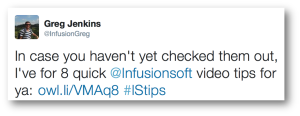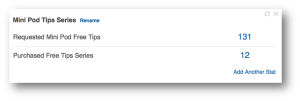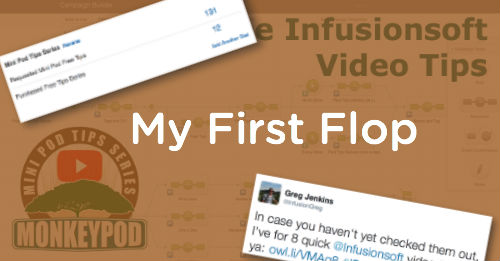So, it’s the end of the year, and I’m back in Michigan visiting my family. I hope you’re enjoying some time with yours as well, if that’s the type of thing you’re into. So, 2015 has been a pretty busy year for me. Most notably I left my job at Infusionsoft, moved to San Diego, and started Monkeypod Marketing.
Pretty much any time I talk to someone that I haven’t seen in a while, I end up answering a few questions about how Monkeypod is going. I don’t mind it one bit because the truth is that it’s going really well. I’ve done some things that I’m really proud of, and the feedback has been really overwhelmingly positive. It hasn’t necessarily taken the shape or direction that I thought it would, but it’s growing every day. Every single one of my virtual courses I’ve launched has been really well received.
Except one.
This brings me to the title of this post, my first flop. You see, I’ve now launched a handful of courses. The CB: Trilogy covers the campaign builder in a comprehensive way; LCM: Real Life is the bridge between Lifecycle Marketing strategy, and the actual campaigns that execute it; and the Ecommerce Pod is a linear approach to understanding and configuring the Infusionsoft ecommerce section. And then there’s the Mini Pod Tips Series, which didn’t make the splash I hoped it would. And I think I know why.
I’m not above admitting when something didn’t go exactly to plan. I’m not perfect, despite what my mom might tell you. In fact, I’ve already taken away some really important lessons from this flop and my hope is that by being transparent about it you can take away something too.
So, I’ve been building and launching courses, right? Well, my courses vary a little in price. They range from $70-80 to $150 or so. And I started thinking “If someone doesn’t know anything about me, asking them to spend $70 might be a little steep.”
So back in August or so I got the bright idea that I needed to have an entry level product, something inexpensive that also allowed people to get to know me, and gave them a taste of what Monkeypod is all about. (Yeah, kind of like tripwire marketing)
So I started to design what that might look like, and the reality is that there are so many different types of Infusionsoft users. For example, some of you reading this are brand new to Infusionsoft, some are veteran users; some of you are solopreneurs who do everything yourself, and some are marketing managers for companies with a few dozen employees. So how could I possible design something that was appealing to everyone?
Well, that’s where the idea of a “Tips Series” came in, so I’d have something for everyone. I put together 20 small, digestible tips and recorded videos explaining and outlining them. Some of thees tips are strategic, some are feature oriented, and some are just “did you know it could do this cool thing”. I spent a lot of time and energy compiling, planning, recording and editing the tips series – and it turned out exactly the way I wanted. The videos are pretty polished and the content is rock solid.
I wanted to make it really accessible, so as to reach a broad audience, so I decided to give away the first 8. Why 8? Because why not. Then, I figured after the 8 videos, once everyone has gotten a feel for who I am and how awesome these tips are, I’d present people with the chance to buy 12 more for $20, so it’d work out to be about $1 per tip. What a steal, right?
Well, I launched it. Promoted it on my social channels, and even put some money into some Facebook ads behind it and people loved the first 8.
But no one was taking the offer for the next twelve videos. Like, seriously, no one.
I remember really clearly that 96 people had signed up for the free 8 before I had one person decide to buy the next twelve. Now I know every industry has their own benchmarks for what they consider to be successful conversion rates; but I’m pretty sure that 1% isn’t what we’re going for.
So I did some homework. I reached out to some people who had taken the 8 tips to try and understand what they liked, or what they didn’t; and also why they decided not to grab the next twelve. And here’s what I learned – nearly every single person had found the first 8 tips valuable. Maybe not every single tip, but there was something for everyone. The problem wasn’t that they weren’t valuable, the problem was that they didn’t solve a need. They didn’t address an issue.
I had created the course for the wrong reason.
You see, all of my other courses were successful because they were solving a direct pain point.
“The campaign builder is hard to learn, and I want to get more out of it.”
Boom, CB: Trilogy.
“Lifecycle Marketing is a good strategy, but I don’t quite know how to actually do it.”
Oh, hello there LCM: Real Life.
“I need to start selling, and there isn’t a linear progression for configuring the Ecommerce section.”
Ask and ye shall receive, Ecommerce Pod.
But the Mini Pod Tips Series, besides being a mouthful on it’s own, had ended up being pretty self-serving. I created a course to introduce myself, and yeah, to demonstrate value. Those are things that I wanted. Not things that people were asking for. I don’t think anyone was sitting around at home thinking to themselves “Man, I wish I had some tips.”
Which is a shame, because the tips series is actually really valuable. I just did a poor job of positioning it. So, I’ve gone back to the drawing board on it, and I made a few changes to the way the campaign functions as well, and things have changed a little; but my real take-away is that I need to stay focused on solving problems. Although, the tweaks have helped too, roughly 30% of the last 35 have ended up taking the offer to buy the extra 12.
 So, all this to say – figure out what problem you’re solving. Stay focused on providing value in a space that needs value. And yes, let your customers tell you what they want (and I’m listening, I’ve got a list of courses I still plan to create). Of course it is a balancing act, we’ve all heard the quote attributed (maybe inaccurately?) to Henry Ford “If I had asked them what they wanted, they would have said faster horses.”
So, all this to say – figure out what problem you’re solving. Stay focused on providing value in a space that needs value. And yes, let your customers tell you what they want (and I’m listening, I’ve got a list of courses I still plan to create). Of course it is a balancing act, we’ve all heard the quote attributed (maybe inaccurately?) to Henry Ford “If I had asked them what they wanted, they would have said faster horses.”
Well, the problem in this case was not that I wasn’t listening, it’s that my courses were had been well received because they were designed to meet a need. Sometimes this need is stated explicitly and sometimes it won’t be.
Oh, and if things don’t go according to plan, make sure you extract a lesson from it (and maybe a blog post too).
Would love to hear about any tough lessons you’ve learned this year in the comments below! Happy holidays everyone, thanks for reading.





Great post, Greg! Love the acknowledgement of business reality: not everything we try succeeds equally… Also love the takeaway to focus on solving customer problems instead of our own. Thanks for sharing!
Thanks man, and thanks for reading. Sometimes it’s fascinating how much we know, and yet how easy it is to lose sight of those very same things.